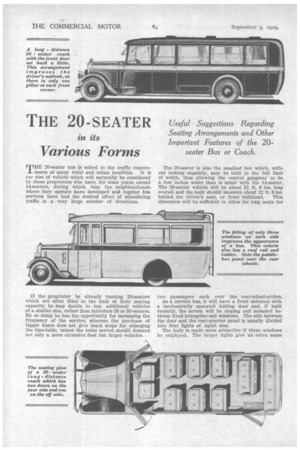THE 20-SEATER
Page 62

Page 63

If you've noticed an error in this article please click here to report it so we can fix it.
in its
Various Forms
Useful Suggestions Regarding Seating Arrangements and Other Important Features of the 20seater Bus or Coach.
MBE 20-seater bus is suited to the traffic require ments of many rural and urban localities. It is toe size of vehicle which will naturally be considered by those proprietors who have, for some years, owned 14-seaters, during which time the neighbourhoods where they operate have developed and regular bus services have had the desired effect of stimulating traffic in a very large number of directions.
If the proprietor be already running 20-seaters which are often filled to the limit of their seating capacity, he may decide to buy additional vehicles of a similar size, rather than introduce 26 or 30-seaters. By so doing he has the opportunity for increasing the frequency of the service, whereas the purchase of bigger buses does not give much scope for enlarging the time-table, unless the route served should demand not otily a more extensive fleet but larger vehicles. The 20-seater is also the smallest bus which, without looking ungainly, may be built to the full limit of width, thus allowing the central gangway to be a few inches wider than is usual with the 14-seater. The 20-seater vehicle will be about 21 ft. 6 ins, long overall and the body should measure about 12 ft. 6 ins.
behind the driver's seat, or front bulkhead. This dimension will be sufficient to allow for long seats for two passengers each over the rear-wheel-arches.
As a service bus, it will have a front entrance with a mechanically operated folding door and, if built recently, the screen will be sloping and mounted between fixed triangular-end windows. The side between the door and the rear-quarter panel is usually divided into four lights of equal size.
The body is made more attractive if three windows be employed. The larger lights give an extra sense of spaciousness and there is the advantage that, with a little contriving, only the centre window need be affected by the wheel-arch, whereas with four windows, only those at the end will, as a rule, drop for their full depth.
This size of bus is usually engaged on routes which include calls at at least one railway station, as well as linking up shopping and market centres with other towns and villages. Therefore, luggage and sundry packages of all kinds will often be carried, so that, if the bus be not -equipped with special luggage lockers, racks or .folding seats, it should be fitted with a roof rail and ladder.
In the case of a vehicle with a track of less than 5 ft., the general appearance will be enhanced if the wheel-arches be covered with paddlebox panels, which will conceal the deep wheel recesses. Each paddle-box may project and have a fiat front with the edge rounded over the point at which it meets the side of the body. On the other hand, it may e shaped so that it is flush with the main panel and have the same vertical curve or
turnunder. In the latter instance, the paddle-box should be painted to match the other panels.
The usual seating plan consists of three pairs of double seats facing forward, a pair of similar seats facing each other, over the wheel-arches and a pair of facing-forward seats at the back; which leave the gangway clear in front of the emergency door.
As a long-distance bus or all-weather coach, the 20-seater is suitable for cross-country work rather than for serving on main routes. The length of the vehicle will vary considerably in accordance with the eomfort and space which is provided for the passeffgers. A typical seating layout consists of six rows of seats. In the first bank is a passenger's seat on the near side of the driver's chair, then there are three pairs of facing-forward seats and, as longitudinal seats must be avoided, if possible, for this class of vehicle, the next row will be placed cross-wise between the wheel-arches. This bank of seats will be designed to hold three passengers and will be placed as near to the off-side wheel-arch as considerations of comfort will allow, leaving more space on the near side if the bus should have a second side entrance. The seats described accommodate 16 passengers and the remaining four people are carried on the back seat, which extends for the full width of the body.
A long-distance coach with this style of seating arrangement will be about a foot longer than a service bus of a similar seating capacity, that is, 22 ft. 6 ins.
long overall, if of a plain design, and from 25 ft. to 25 ft. 6 ins. longif a buffet and lavatory be included.
When there are two near-side entrances, the elevation may be varied as follows :—In one instance there are three windows between the two side doors and either a plain quarter panel or a small window behind the second door. As an alternative, the front entrance may be placed opposite the first row of seats behind the driver's compartment. There is then a window between this door and the windscreen. This light has a sloping front and the usual small triangillar=end windows are omitted. This gives the vehicle an elegant frontal appearance, which may be enhanced if a metal, instead of a wood, pillar be used. This staggered line may be emphasized by carrying the line of the pillar down to the level of the chassis.




















































































































